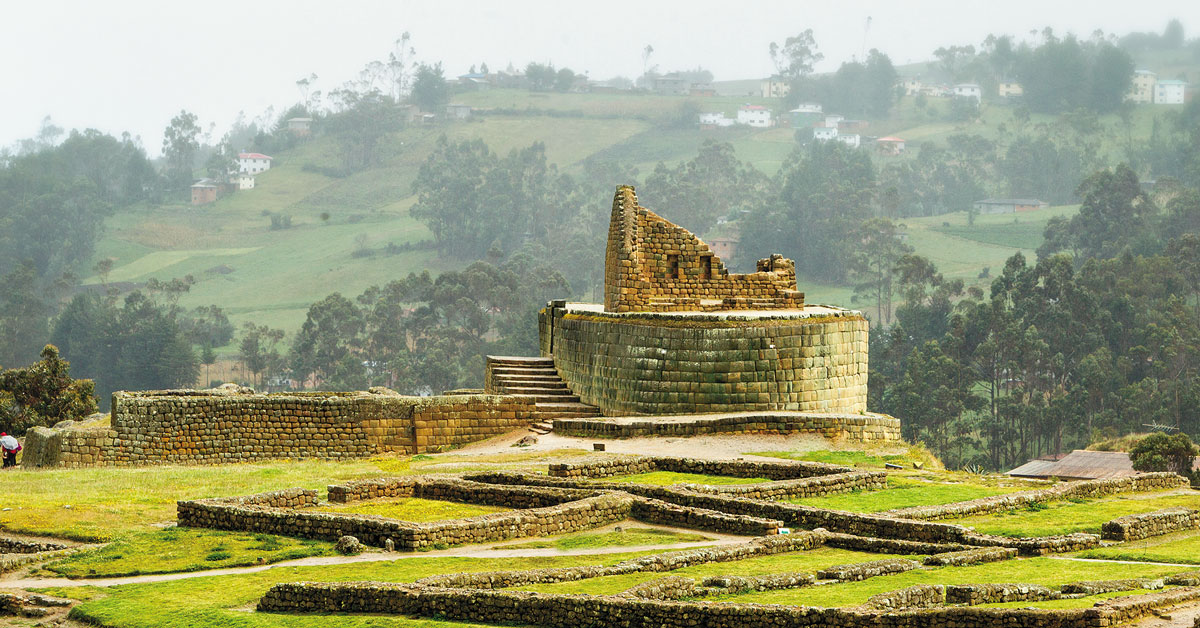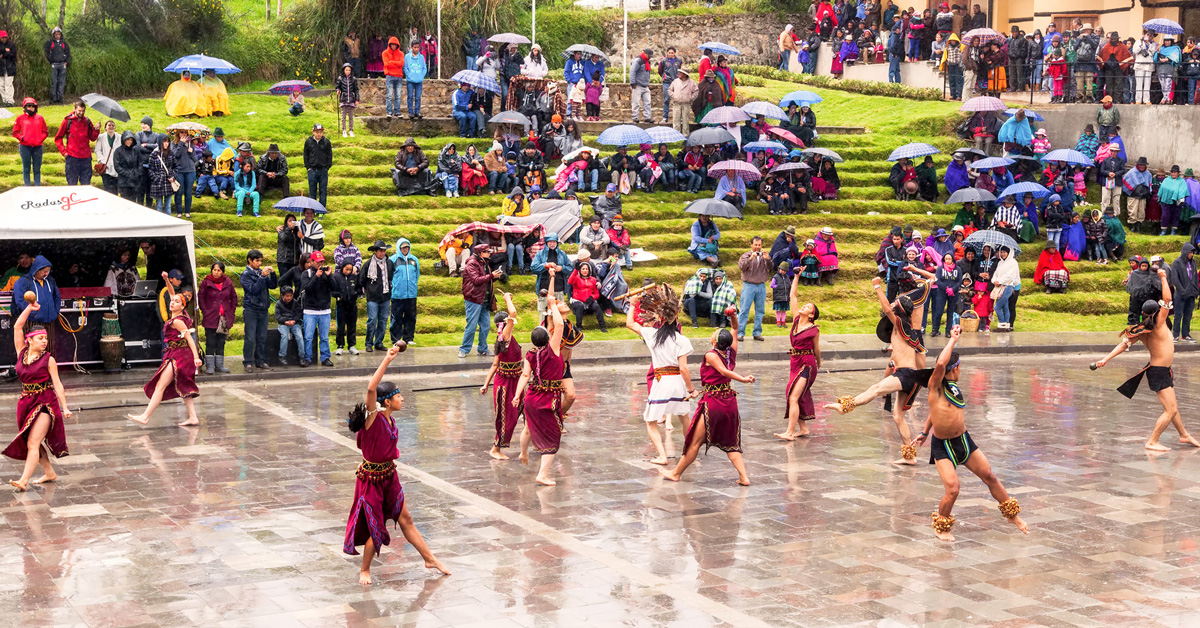Visiting Ecuador’s Ingapirca Ruins
Ingapirca, which means “Inca wall” in Kichwa, is Ecuador’s most important set of pre-Columbian ruins, located 80 km (50 mi) north of Cuenca. The Inca sun temple perched on its hill with panoramic views of the surrounding countryside is an impressive sight, and the ruins have a fascinating history.

History
The Cañari lived here long before the Incas arrived and are famous for their determined resistance of the invasion, successfully defending their territory against the army of Inca ruler Túpac Yupanqui. It wasn’t until Yupanqui’s son, Huayna Capac, continued his father’s campaign that the Incan empire finally conquered Cañari territory, through a combination of wars and marriages. Interestingly, following their victory, the invaders had enough respect for the Cañari to build a community together, constructing their own Temple of the Sun to complement the existing Temple of the Moon. As well as a ceremonial site, Ingapirca is thought to have had astronomical, political, and administrative functions. A few high-status individuals and families resided there, visited occasionally by Huayna Capac’s son, Atahualpa.
At 3,200 m (10,500 ft) elevation, Ingapirca’s position overlooking the surrounding valley was of key strategic importance, but its growth was short-lived. The complex is thought to have been destroyed shortly before the Spanish conquest, in a war between Atahualpa and his brother Huáscar in 1532. The Spanish later ransacked the site, and much of the stonework was used to build churches and haciendas in Cuenca and beyond. The site lay abandoned until the Ecuadorian government began a restoration process in the mid-20th century, opening the site to the public in 1966.
Newsletter Signup
By clicking ‘Sign Up,’ I acknowledge that I have read and agree to Hachette Book Group’s Privacy Policy and Terms of Use
The Site

Much of the site is little more than stone foundations, and it takes imagination and a guided tour to bring it to life. The Pilaloma complex on the south side marks the original Cañari settlement. The most interesting feature is the collective tomb of a Cañari priestess and 10 of her servants, who were buried alive with her upon her death, along with thousands of spondylus shells. The tomb lies under a large stone that is thought to be linked to various astronomical calculations and was possibly used as a sacrificial altar.
Farther into the complex, there is an expansive open space where large numbers of devotees gathered for ceremonies. Just beyond this, a fragment of Inca road remains, part of a network that once connected religious and administrative centers across Ecuador, Peru, Colombia, Bolivia, Argentina, and Chile. Other features include ceremonial baths, agricultural terraces, and grain storage areas.
The highlight of the complex is the elliptical Temple of the Sun, the only one of its kind in the Incan empire, built on top of an ancient Cañari ceremonial rock. It is thought that, in addition to being a site for rituals, the structure was used to determine the agricultural and religious calendars. The most important event was Inti Raymi, the Festival of the Sun, which is still celebrated at Ingapirca every June. The mind-boggling stonework that is the hallmark of Inca construction can be fully appreciated here, with volcanic rocks hand-carved so precisely that mortar was unnecessary.
Next to the temple is the House of the Chosen, where the most beautiful girls from the neighboring villages lived as Virgins of the Sun. Removed from their families as children, they were taught how to dance, embroider, weave, and cook. Their duties included entertaining visiting Incan dignitaries, preparing ceremonial food, maintaining a sacred fire, and weaving garments for the emperor and for rituals. They would go on to marry high-ranking men such as Incas, distinguished soldiers, and priests.
Also near the temple is a large stone with 28 holes of varying sizes, thought to have been a lunar calendar. It is believed that the holes were filled with water, which told the date by reflecting the moon’s light differently throughout the month. A 20-minute walk from the temple is a cliff in which appears a giant human face known as the Cara del Inca, thought to be a natural phenomenon.
Near the entrance is a small museum (included in the entrance fee) that houses a collection of Cañari and Inca ceramics, sculptures, tools, traditional dress, and a skeleton found at the site. There are several handicrafts shops and cafés selling traditional fare.
Visiting Ingapirca
The Complejo Arqueológico de Ingapirca (tel. 7/221-7107, 8:30am-5pm Wed.-Sun., $2) requires visitors to complete a reservation form, found on their Facebook page, 72 hours ahead of their visit. The entrance fee includes an obligatory 45-minute tour. Signs in Spanish, English, and Kichwa explain the basics of the site, but few of the guides speak much English. If you don’t speak Spanish and would like to get the most out of your experience, consider going with an organized day trip from Cuenca (available from most tour companies for $50 pp).
Tour agencies in Cuenca also offer a one-day hike on the Inca road through the páramo, which starts at the beautiful Culebrillas lake near Cañar and ends at Ingapirca. Even more adventurous is a three-day trek on the Inca road, which starts in Achupallas near Alausí and continues through pristine Ecuadorian páramo in Sangay National Park to Ingapirca, passing beautiful lagoons and the ruins of stone buildings where Incan messengers took refuge. With a maximum elevation of 4,200 m (13,780 ft), this is one of the highest points of the Inca road. Keep in mind that you’ll be hiking at over 3,000 m (9,800 ft) elevation the whole way, and that the weather can change quickly. Bring lots of warm clothes and keep your waterproof jacket handy. Andén Tours (tel. 99/959-7882) is a recommended tour agency offering the standard day trip to Ingapirca, as well as the one-day hike ($90 pp) and the three-day trek ($320 pp for 2 people, including mules, tents, meals, and rubber boots).

Ingapirca is a good place to join the Inti Raymi celebrations, a traditional Incan ceremony in honor of the god Inti (Quechua for “sun”), the most venerated deity in the Inca religion. Indigenous groups from Ecuador and other Andean countries gather at Ingapirca for traditional dancing, music, gastronomy, and craft fairs for three days between June 17-23. Check the Ingapirca Facebook page for exact dates; admission to the event is included in the site entrance fee.
Transportes Cañar (tel. 7/284-3940) has direct buses from the terminal terrestre in Cuenca to Ingapirca (9am and 12:20pm Wed.-Fri., 9am Sat.-Sun., 2.5 hours, $3.50). If you miss the direct bus, there are regular buses to Cañar (90 minutes, $0.90) and Tambo (2 hours, $3), where you can change for Ingapirca (30 minutes, $0.75). Similarly, if you’re traveling from the north along the Panamericana, get out at Cañar or Tambo.
In a restored 200-year-old estate just 300 m (980 ft) from the ruins, Posada Ingapirca (tel. 7/283-1120 or 99/309-9131, $52 s, $71 d, including breakfast) has comfortable, rustic guest rooms, each with a chimney or heater. The restaurant ($11) is open to non-guests and has a fireplace. It serves local specialties such as trout, fritada (pork cooked in orange juice), mote pillo (hominy scrambled with egg), and llapingachos (potato patties).
Newsletter Signup
By clicking ‘Sign Up,’ I acknowledge that I have read and agree to Hachette Book Group’s Privacy Policy and Terms of Use
Pin It for Later






